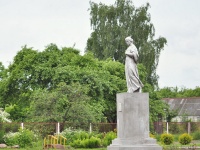- Home
- →
- Attractions
- →
- Monument to A. Pashkevich (Tetka) in Ostrino
Monument to A. Pashkevich (Tetka) in Ostrino
Monument to Aloiza Pashkevich — Belarusian poet, public and political figure, actress, and educator — was erected in the town of Ostrino in 1954.
Aloiza was born into a noble family. In 1902–1903, she studied at the Courses for Female Educators and Physical Education Instructors (Higher Courses of Lesgaft) in Saint Petersburg. Although she did not complete the course, she passed an external examination for the full course of the Alexandrovskaya Women's Gymnasium. It is believed that in Saint Petersburg, Pashkevich actively participated in the activities of the Student Circle for Belarusian National Education and Culture and authored several texts published by this circle.
Beginning of Social and Political Activities
In 1904, Aloiza Pashkevich started working as a paramedic in a hospital in Novaya Vileyka (now Naujoji Vilnia, a district of Vilnius), while simultaneously engaging in propaganda work. She actively participated in the Belarusian Socialist Community, maintaining connections with Lithuanian and Russian social democrats, including Mickevičius-Kapsukas and Boris Vigilyov, an associate of Vladimir Lenin. Fearing arrest, Pashkevich left the Russian Empire in 1905.
Personal Life and Social Circle
She was married to Steponas Kairys, the future Deputy Prime Minister of the Lithuanian Republic in 1918. In Soviet literature, this marriage was considered fictitious because Kairys opposed the communists. Pashkevich was friends and collaborated with prominent figures such as Eliza Orzeszkowa, Čiurlionis, Lithuanian poet Jonas Biliūnas, Ukrainian linguist Illarion Sventsitskyi, and Polish futurist Jerzy Jankowski. She studied philosophy, philology, and history at universities in Krakow and Lviv and traveled to Finland, Sweden, and Italy.
Return, Literary and Theatrical Activities
After returning from emigration, Pashkevich became an actress in Ignat Buynitsky’s theater and the editor of the youth magazine "Luchynka." Her work reflects love for her homeland, resistance to social injustice, and dedication to the people. Among her works are the collections "Khrest na Svabodu" and "Skrypka Belaruskaya," as well as children's books "Pershae Chytanne dlya Dzetak Belarusaŭ," "Lemantar," and "Hastsinets dlya Malykh Dzetsey."
Last Years and Tragic Death
With the outbreak of World War I, Aloiza Pashkevich worked as a nurse in the Vilnius military hospital, caring for typhus patients. In 1916, after attending her father’s funeral, she contracted typhus and passed away. She was buried in her native village of Starye Dvory.
Legacy and Influence
Pashkevich's work significantly influenced Belarusian literature and social thought. Her works have been translated into Russian, Ukrainian, Bulgarian, Czech, German, and Lithuanian.

